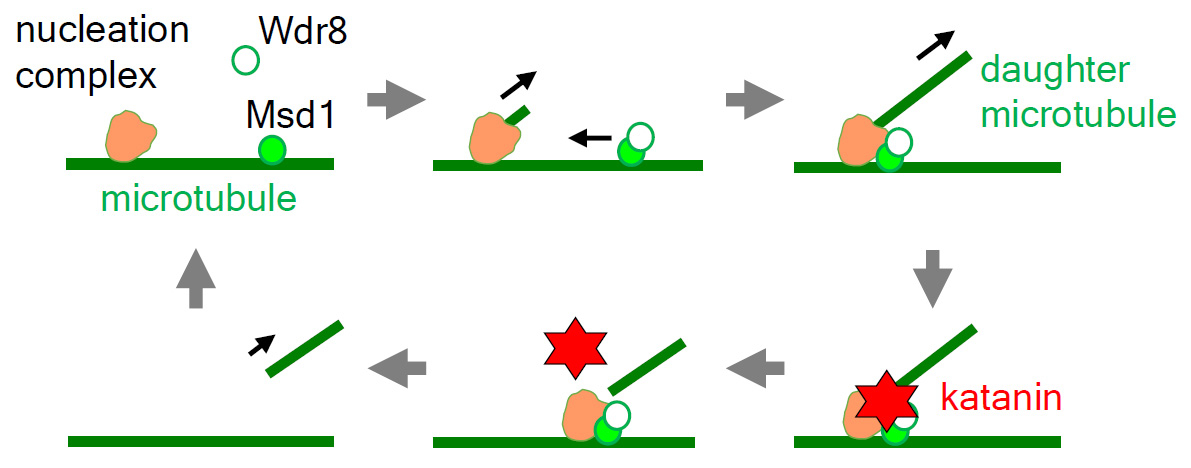Research outcomes
Hired blade: Anchoring complex in plant cells recruits its own katana sword
Researchers from Nara Institute of Science and Technology find that an anchoring complex stabilizes microtubule creation sites within plant cells, then recruits katanin - named after the katana sword - to cut new microtubules
Ikoma, Japan - The katana, a Japanese sword, may be thought of solely as a weapon used by the samurai. But researchers from Japan have discovered that not only do plants wield their own katanas within their cells, they recruit them to specific locations within those cells to do their work.

In wild-type plant cells, lattice-bound Msd1 (filled green circle) recruits cytoplasmic Wdr8 (open green circle) to form a heteromeric complex, which is translocated to and associated with a microtubule nucleation complex (orange) on a preexisting microtu
In a study published in Nature Communications , researchers from Nara Institute of Science and Technology have revealed that the enzyme katanin, which is named after the katana, is used by an anchoring complex to cut microtubules at specific locations of the framework within individual plant cells.
Katanin severs microtubules in cells, which is an important step in cell division and central to the development of many organisms, including plants and animals. Microtubules form part of the cytoskeleton, a complex network of protein filaments found in all cells. The severing performed by katanin enables mobility, which is important during development, and treadmilling - a phenomenon where one end of a filament lengthens as the other shrinks, which results in a section of filament that seems to 'move' like a treadmill.
"Katanin severs microtubules at specific locations in plant and animal cells, and this leads to active reorganization of the microtubule cytoskeleton," says senior author of the study Takashi Hashimoto. "But the mechanisms for targeting this extraordinary enzyme at specific sites within the cell are not well understood - these are what we wanted to investigate."
The team's genetic and cell biology research results showed that the microtubule anchoring complex Msd1-Wdr8 is used to stabilize microtubule nucleation sites (where microtubules are formed) in plant cells to prevent early release of the new microtubules (called 'daughter microtubules'). But in a seemingly counterintuitive twist, Msd1-Wdr8 then turns around and recruits katanin to the same location to enable the efficient release of daughter microtubules.
"These 'glue-and-cut' functions performed by Msd1-Wdr8 and their effects on microtubule stability may seem confusing at first, but they probably enable strict control of microtubule release by the katanin activity," explains Hashimoto.
This study will inform future research on whether the Msd1-Wdr8 complex in animal cells also recruits katanin, and whether other sites use similar mechanisms for the stabilization and release of daughter microtubules. The results of this study will be of interest to cell biologists, especially those working on cytoskeletons, in plants and other organisms.
###
Resource
Title: An anchoring complex recruits katanin for microtubule severing at the plant cortical nucleation sites
Authors: Noriyoshi Yagi, Takehide Kato, Sachihiro Matsunaga, David W. Ehrhardt, Masayoshi Nakamura & Takashi Hashimoto
Journal: Nature Communications
DOI: 10.1038/s41467-021-24067-y
Information about project leader Hashimoto's lab can be found at the following website:
https://bsw3.naist.jp/eng/courses/courses103.html
( June 22, 2021 )
